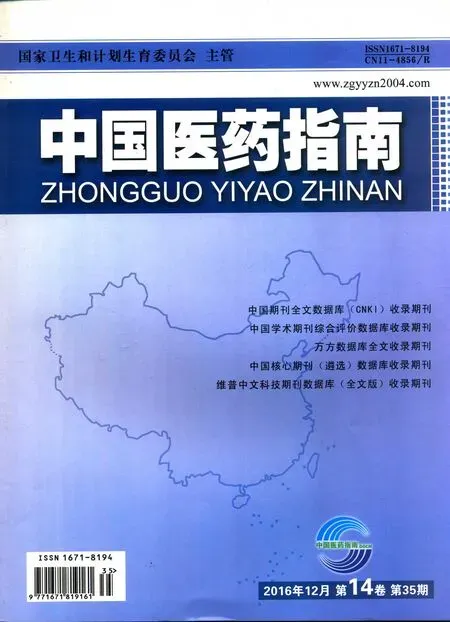腔内碎石术治疗输尿管结石术后感染的预防研究
王相平 纪晓君 管殿尧 宋晓楠
(大连市第五人民医院泌尿外科,辽宁 大连 116021)
腔内碎石术治疗输尿管结石术后感染的预防研究
王相平 纪晓君 管殿尧 宋晓楠
(大连市第五人民医院泌尿外科,辽宁 大连 116021)
目的 探讨腔内碎石术治疗输尿管结石术后感染的预防。方法 选择2014年1月至2015年10月在医院行腔内碎石术治疗输尿管结石的284例输尿管结石患者,采集感染患者的中段尿液标本进行细菌培养、鉴定及药敏实验,并对术后感染的原因进行分析。结果 术后感染35例,感染率为12.32%。共检出162株病原菌,其中革兰阳性菌35株占19.75%,革兰阴性菌108株占66.67%,真菌19株占11.73%。粪肠球菌对青霉素及氧氟沙星具有较高的耐药率,而对万古霉素及安可西林非常敏感;金黄色葡萄球菌对氧氟沙星、链霉素较为敏感,尤其是万古霉素;表皮葡萄球菌对氧氟沙星及青霉素耐药率较高。大肠埃希菌、肺炎克雷伯菌、铜绿假单胞菌对哌拉新林及亚胺培南非常敏感,而对安可西林、环丙沙星具有较高的耐药率。经Logistic回归分析,年龄≥60岁、合并糖尿病、术前尿路感染、输尿管上段结石、多发结石、结石≥1 cm、手术时间≥50 min、术中灌注压≥60 mm Hg、输尿管弹道碎石为腔内碎石术治疗输尿管结石术后感染的独立因素。结论 龄≥60岁、合并糖尿病、术前尿路感染、输尿管上段结石、多发结石、结石≥1 cm、手术时间≥50 min、急性梗阻、术中灌注压≥60 mm Hg、输尿管弹道碎石术为腔内碎石术治疗输尿管结石术后感染的独立因素。针对相关因素积极采取相应的对策,以降低腔内碎石术治疗输尿管结石术后感染的发生率。
腔内碎石术;输尿管结石;术后感染;影响因素;预防
本次研究选择2014年1月至2015年10月在医院行腔内碎石术治疗输尿管结石的284例输尿管结石患者作为研究对象,探讨腔内碎石术治疗输尿管结石术后感染的预防,报道如下。
1 资料与方法
1.1 一般资料:选择2014年1月至2015年10月在医院行腔内碎石术治疗输尿管结石的284例输尿管结石患者。
1.2 方法
1.2.1 细菌培养、鉴定及药敏实验:在无菌条件下采集感染患者的中段尿液标本立即放入培养瓶中送检,采用细菌检定仪(法国生物梅里埃公司生产,型号:VITEK-32)对采集培养的菌种进行鉴定。药敏试验采用K-B纸片琼脂扩散法,按照美国临床实验室标准化委员会(NCCLS)标准[1]来判定结果。
1.2.2 研究方法:对所有腔内碎石术治疗输尿管结石患者的病例资料进行汇总、统计分析,主要包括患者的性别、年龄、合并糖尿病、术前尿路感染、结石位置、结石数量、结石大小、手术时间、梗阻情况、术中灌注压等信息,对术后感染的相关因素进行初步筛选,并通过Logistic回归分析关联较大的独立危险因素,并制定相应的措施,以降低术后感染的发生率。
1.3 统计学处理:采用 SPSS18.0 统计学软件对数据进行统计学分析。计数资料采用χ2检验,并通过Logistic回归分析关联较大的独立危险因素,P<0.05 表示差异有统计学意义。
2 结 果
2.1 感染情况:284例腔内碎石术治疗输尿管结石术患者术后感染35例,感染率为12.32%。
2.2 医院感染患者病原菌分布:共检出162株病原菌,其中革兰阳性菌35株占19.75%,革兰阴性菌108株占66.67%,真菌19株占11.73%。见表1。
Prevention Research Lithotripsy of Ureteral Calculi Postoperative Infection
WANG Xiang-ping, JI Xiao-jun, GUAN Dian-yao, SONG Xiao-nan
(Department of Urology, Dalian Fifth People’s Hospital, Dalian 116021, China)
ObjectiveTo investigate the lithotripsy of ureteral calculi postoperative infection prevention.MethodsJanuary 2014 -2015 in October Hospital of lithotripsy of ureteral calculi 284 cases of ureteral calculi patients infected patients collect midstream urine specimen for bacterial culture, identifcation and susceptibility testing, and surgery Cause after infection were analyzed.Results35 cases of postoperative infection, the infection rate was 12.32%. 162 were detected pathogens, including gram-positive bacteria 35 accounted for 19.75%, Gram-negative bacteria 108 accounted for 66.67%, accounting for 11.73% of fungi 19. Enterococcus faecalis penicillin and ofoxacin has a high resistance rate, while Encore resistant to vancomycin and very sensitive; Staphylococcus aureus ofoxacin, more sensitive to streptomycin, especially vancomycin prime; Staphylococcus epidermidis ofoxacin and a higher rate of penicillin-resistant. Escherichia coli, Klebsiella pneumoniae, Pseudomonas aeruginosa to piperacillin and imipenem new forest is very sensitive, while the encore amoxicillin, ciprofoxacin has a high resistance rate. After Logistic regression analysis, age≥60 years, diabetes, preoperative urinary tract infection, upper ureteral stones, multiple stones, stones≥1 cm, operative time≥50 min, intraoperative perfusion pressure≥60 mm Hg, lithotripsy of ureteral lumen broken independent factors ureteral stones stone treatment of postoperative infection.ConclusionsAge≥60 years, diabetes, preoperative urinary tract infection, upper ureteral stones, multiple stones, stones≥1 cm, operative time≥50 min, acute obstruction, intraoperative perfusion pressure≥60 mm Hg, ureteral lithotripsy intraluminal independent factors of postoperative infection ureteral calculi lithotripsy. Actively take appropriate measures for the relevant factors in order to reduce lithotripsy of ureteral calculi incidence of postoperative infection.
Lithotripsy; Ureteral calculi; Postoperative infection; Infuencing factors; Prevention
R693+.4
B
1671-8194(2016)35-0003-02

